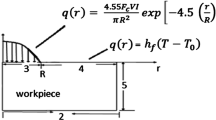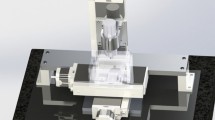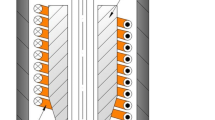Abstract
Application of external magnetic field in electrical discharge machining is one of the methods to increase this process capability and decrease its limitations. In the present study, a single discharge in magnetic field-assisted electrical discharge machining has simulated using finite element method in order to obtain the temperature distribution and generated crater dimensions on the workpiece surface. A new mathematical model for plasma channel radius was also developed and used at simulation stage. Regarding good agreement between recast layer thickness obtained by numerical and experimental methods with maximum error of 8.8%, the effects of applying external magnetic fields on plasma flushing efficiency and recast layer thickness were found numerically and experimentally. Also the influences of pulse current and pulse on-time on dimensions of generated craters at magnetic field-assisted EDM were studied numerically. The results showed the positive effects of application of external magnetic field in EDM process on increasing plasma flushing efficiency and decreasing recast layer thickness.
Similar content being viewed by others
References
Chang GW, Yan BH, Hsu RT (2002) Study on cylindrical magnetic abrasive finishing using unbonded magnetic abrasives. Int J Mach Tools Manuf 42:575–583
Yamaguchi H, Shinmura T (2004) Internal finishing process for alumina ceramic components by a magnetic field-assisted finishing process. Precis Eng 28:135–142
Kim JD (2003) Polishing of ultra-clean inner surfaces using magnetic force. Int J Adv Manuf Technol 21:91–97
Teimouri R, Baseri H (2012) Study of tool wear and overcut in EDM process with rotary tool and magnetic field. Advances in Tribology 2012(Article ID 895918):8
De Bruijn HE, Delft TH, Pekelharing AJ (1978) Effect of a magnetic field on the gap cleaning in EDM. Annals of CIRP 27:93–95
Teimouri R, Baseri H (2012) Effects of magnetic field and rotary tool on EDM performance. J Manuf Process 14:316–322
Zhao B, Xu X, Cai G, Kang R (2009) Experimental and mechanism research on EDM combined with magnetic field. Key Eng Mater 416:337–341
Lin YC, Lee HS (2009) Optimization of machining parameters using magnetic-force-assisted EDM based on gray relational analysis. Int J Adv Manuf Technol 42:1052–1064
Lin YC, Chen YF, Wang DA, Lee HS (2009) Optimization of machining parameters in magnetic force assisted EDM based on Taguchi method. J Mater Process Technol 209:3374–3383
Govindan P, Gupta A, Joshi SS, Malshe A, Rajurkar KP (2013) Single-spark analysis of removal phenomenon in magnetic field assisted dry EDM. J Mater Process Technol 213:1048–1058
Joshi S, Govindan P, Malshe A, Rajurkar K (2011) Experimental characterization of dry EDM performed in a pulsating magnetic field. CIRP annals- manufacturing. Technology 60:239–242
Cao MR, Geng XD (2011) Process research on high-speed small hole drilling by EDM combined with magnetic field and water dispersant. Adv Mater Res 189:269–272
Heinz K, Surla V, Kapoor SG, DeVor RE (2011) An investigation of magnetic-field-assisted material removal in micro EDM for nonmagnetic materials. J Manuf Sci Eng 133(2):9 021002
Lee HT, Yur JP (2000) Characteristic analysis on EDMed surfaces using Taguchi method approach. Mater Manuf Process 15(6):781–806
Lee HT (1996) Influence of EDM process parameters on surface defects and roughness. Chin J Mater Sci 28(4):270–278
Shabgard MR, Gholipoor A, Mohammadpourfard M (2018) Numerical and experimental study of the effects of ultrasonic vibrations of tool on machining characteristics of EDM process. Int J Adv Manuf Technol 96 (5): 2657–2669
Van Dijck F, Dutre W (1974) Heat conduction model for the calculation of the volume of molten metal in electric discharges. J Phys D Appl Phys 7(6):899–910
Allen P, Chen X (2007) Process simulation of micro electro-discharge machining on molybdenum. J Mater Process Technol 186(1):346–355
Murali MS, Yeo SH (2005) Process simulation and residual stress estimation of micro-electro discharge machining using finite element method. Jpn J Appl Phys 44:52–54
Yada V, Jain VK, Dixit PM (2002) Thermal stresses due to electrical discharge machining. Int J Mach Tools Manuf 42(8):877–888
Rajurkar K, Pandit S (1984) Quantitative expressions for some aspects of surface integrity of electro discharge machined components. J Eng Ind (Trans. ASME) 106(2):171–177
Dibitonto DD (1989) Theoretical models of the electrical discharge machining process. I. A simple cathode erosion model. J Appl Phys 66(9):4095–4103
Yeo SH, Kurnia W, Tan PC (2007) Electro-thermal modeling of anode and cathode in micro-EDM. J Phys D Appl Phys 40:2513–2521
Snoeys R, Van Dijck F (1971) Investigation of electro discharge machining operations by means of thermo-mathematical model. CIRP Ann 20(1):35–37
Jilani TS, Pandey P (1983) An analysis of surface erosion in electrical discharge machining. Wear 84(3):275–284
Shabgard M, Ahmadi R, Seyedzavvar M, Bavil Oliaei SN (2013) Mathematical and numerical modeling of the effect of input-parameters on the flushing efficiency of plasma channel in EDM process. Int J Mach Tool Manu 65:79–87
Halliday D, Resnick R, Walker J (2013) Fundamentals of physics extended, 10th edition. John Wiley & Sons
Eubank PT, Patel MR, Barrufet MA, Bozkurt B (1993) Theoretical models of the electrical discharge machining process. III. The variable mass, cylindrical plasma model. J Appl Phys 73(11):7900–7909
Ryzko H (1965) Drift velocity of electrons and ions in dry and humid air and in water vapor. Proc Phys Soc 85(6):1283–1295
Descoeudres A (2006) characterization of electrical discharge machining plasmas; Ph. D Thesis; The Victoria University of Manchester
Francis CK, Bennett HT (1922) The surface tension of petroleum. J Indus Eng Chem 14(7):626–627
Wang F, Wu J, Liu Z (2006) Surface tensions of mixtures of diesel oil or gasoline and dimethoxymethane, dimethyl carbonate, or ethanol. Energy Fuel 20:2471–2474
Loo KH, Moss GJ, Tozer RC, Stone DA, Jinno M, Devonshire R (2004) A dynamic collisional-radiative model of a low-pressure approach to modeling fluorescent lamps for circuit simulations. IEEE Trans Power Electron 19(4):1117–1129
Albinskiy K, Musiol K, Miernikiewicz A, Labuz S, Malota M (1996) The temperature of a plasma used in electrical discharge machining. Plasma Sources Sci Technol 5:736–742
Sen SN, Das RP (1973) Effect of magnetic field on primary ionization by electron collision. Int J Electron 39(6):448–457
Francis F C (2016) Introduction to plasma physics and controlled fusion, 2nd Edition, Springer international publishing Switzerland
Salonitis K, Stournaras A, Stavropoulos P, Chryssolouris G (2009) Thermal modeling of the material removal rate and surface roughness for die-sinking EDM. Int J Adv Manuf Technol 40:316–323
Marafona J, Chousal JAG (2006) A finite element model of EDM based on Joule effect. Int J Mach Tool Manu 46:595–602
Author information
Authors and Affiliations
Corresponding author
Rights and permissions
About this article
Cite this article
Shabgard, M.R., Gholipoor, A. & Mohammadpourfard, M. Investigating the effects of external magnetic field on machining characteristics of electrical discharge machining process, numerically and experimentally. Int J Adv Manuf Technol 102, 55–65 (2019). https://doi.org/10.1007/s00170-018-3167-3
Received:
Accepted:
Published:
Issue Date:
DOI: https://doi.org/10.1007/s00170-018-3167-3




